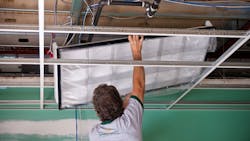Managers of older school facilities should be vigilant about making sure aging fluorescent lighting fixtures are not leaking hazardous chemicals.
The U.S. Environmental Protection Agency says that fluorescent ballasts manufactured before 1979 may contain polychlorinated biphenyls (PCBs), which Congress banned in 1979 because they pose health risks. Research had determined that exposure to high levels of PCBs may lead to a variety of health problems, including cancer.
“Any building built before 1979 is likely to have PCB-containing ballasts if it has not undergone a complete lighting retrofit after 1979,” the EPA says.
The PCBs in such ballasts would be found in two places, the EPA says. About 1 to 1½ ounces of PCBs would be in the capacitor, and lower levels would be in the potting compound, a black, tar-like substance that encapsulates the internal electrical components. Leaks are typically a clear to yellow oily liquid, the PCB oil itself, or the liquefied potting material. If the ballast fails or overheats, the capacitor may break open, and both its oil and the potting material may be released from the fixture.
Any ballasts with PCBs that are still in use in schools have far exceeded the life expectancy for the fixtures; this makes them more likely to fail and leak the hazardous chemical or cause a fire. “The hazard can be worsened by mishandling by personnel who are unaware of the presence of PCBs in the lighting ballasts,” the EPA says. “Such an incident can increase exposure of students and school personnel to PCBs.”
Even if schools do not find any signs of leaking in pre-1979 ballasts, the EPA urges school systems to remove the fixtures expeditiously.
“A ballast leak or fire could happen at any time, and without warning add PCB levels in the air,” the EPA says. “Postponing a lighting retrofit and betting on the structural integrity of old ballasts may result in health and educational impacts for your students and staff and serious cost impacts for your budget.”
The EPA says it has seen evidence of leaking PCBs in light ballasts in schools in Oregon, North Dakota, and Massachusetts. But the most extensive instance of problematic older fixtures is in New York City schools. The city determined that more than 750 of its schools have T-12 fluorescent lighting fixtures that may contain PCBs.
The school district has begun replacing the potentially dangerous ballasts, but because of the amount of fixtures involved and the costs of removing them, the project will take 10 years to complete. As it conducts regular visual inspections of T-12 fluorescent fixtures that potentially contain PCB ballasts, it is replacing any where leaks have been found. School buildings where a leaking fixture has been found are given a higher priority for replacing all older fixtures.
A group of parents who say the 10-year time frame for removing ballasts is too long has sued the district in an effort to have the work done more quickly. The city has sought to have the case dismissed, but U.S. District Court Judge Sterling Johnson has rejected the city’s arguments as “deceptive or illogical.”
“The Court will not begrudge the City its right to zealous advocacy, but neither will the Court abide the City’s insouciant foot-dragging, which, in the end, is all that can be said for its position,” the judge wrote. “With the cognitive development of children at stake, it would have been refreshing to see humanitarian concerns trump the compulsion to delay litigation with quite so many spurious arguments. But some dreams remain deferred.”
About the Author
Mike Kennedy
Senior Editor
Mike Kennedy, senior editor, has written for AS&U on a wide range of educational issues since 1999.
